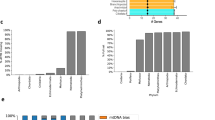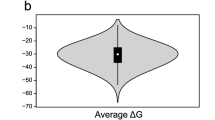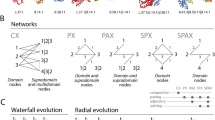Abstract
All the evidence so far points to a gene's protein-coding information being contained in only one of its two DNA strands, with this strand serving as a template for transcription of the precursor RNA that is eventually translated into protein1. Here we present structural evidence showing that the protein-coding information of the modifier of mdg4 (mod(mdg4)) gene of the fruitfly Drosophila is provided by both of its complementary DNA strands, and not by just one. This novel organization means that RNA precursors generated from two DNA templates need to be joined subsequently into a single messenger RNA, a surprising feature that raises new questions regarding genome complexity and evolution.
This is a preview of subscription content, access via your institution
Access options
Subscribe to this journal
Receive 51 print issues and online access
$199.00 per year
only $3.90 per issue
Buy this article
- Purchase on SpringerLink
- Instant access to full article PDF
Prices may be subject to local taxes which are calculated during checkout

Similar content being viewed by others
References
Burge, C. B., Tuschl, T. & Sharp, P. A. in The RNA World 2nd edn (eds Gesteland, R. F., Cech, T. R. & Atkins, J. F.) 525–560 (Cold Spring Harbor Laboratory Press, New York, 1999).
Gerasimova, T. I., Gdula, D. A., Gerasimov, D. V., Simonova, O. & Corces, V. G. Cell 82, 587–597 (1995).
Gerasimova, T. I. & Corces, V. G. Cell 92, 511–521 (1998).
Buchner, K. et al. Genetics 155, 141–157 (2000).
Adams, M. D. et al. Science 287, 2185–2195 (2000).
Agabian, N. Cell 61, 1157–1160 (1990).
Caudevilla, C. et al. Proc. Natl Acad. Sci. USA 95, 12185–12190 (1998).
Harvey, A. J., Bidwai, A. P. & Miller, L. K. Mol. Cell. Biol. 17, 2835–2843 (1997).
Burge, C. B. & Karlin, S. Curr. Opin. Struct. Biol. 8, 346–354 (1998).
Solnick, D. Cell 42, 157–164 (1985).
Author information
Authors and Affiliations
Corresponding author
Rights and permissions
About this article
Cite this article
Labrador, M., Mongelard, F., Plata-Rengifo, P. et al. Protein encoding by both DNA strands. Nature 409, 1000 (2001). https://doi.org/10.1038/35059000
Issue date:
DOI: https://doi.org/10.1038/35059000
This article is cited by
-
A chimeric transcript containing Psy1 and a potential mRNA is associated with yellow flesh color in tomato accession PI 114490
Planta (2014)
-
Predicting mutually exclusive spliced exons based on exon length, splice site and reading frame conservation, and exon sequence homology
BMC Bioinformatics (2011)
-
Expansion of the eukaryotic proteome by alternative splicing
Nature (2010)
-
Trans-splicing in C. elegans generates the negative RNAi regulator ERI-6/7
Nature (2008)
-
Highly expressed genes are associated with inverse antisense transcription in mouse
Journal of Genetics (2007)



